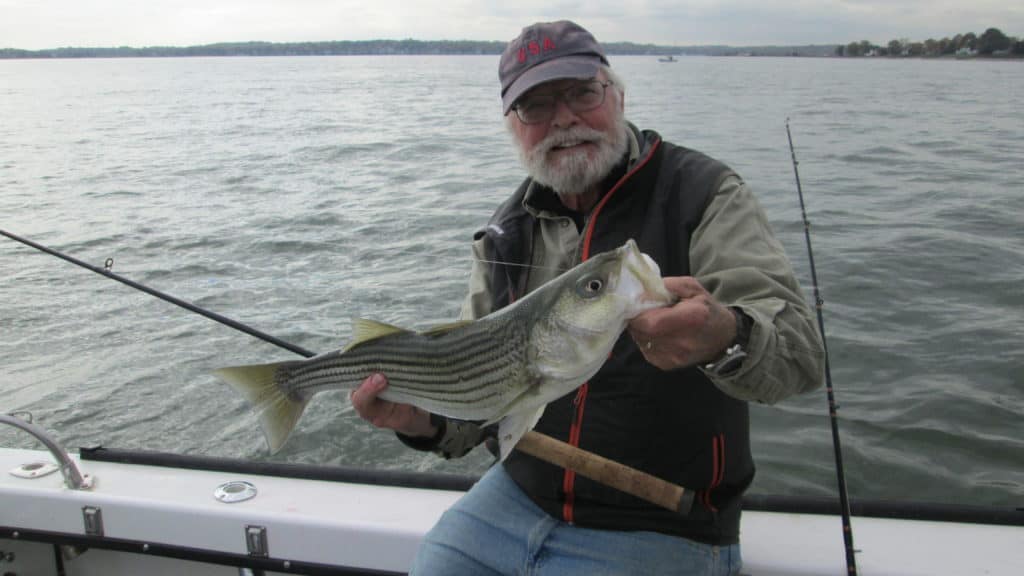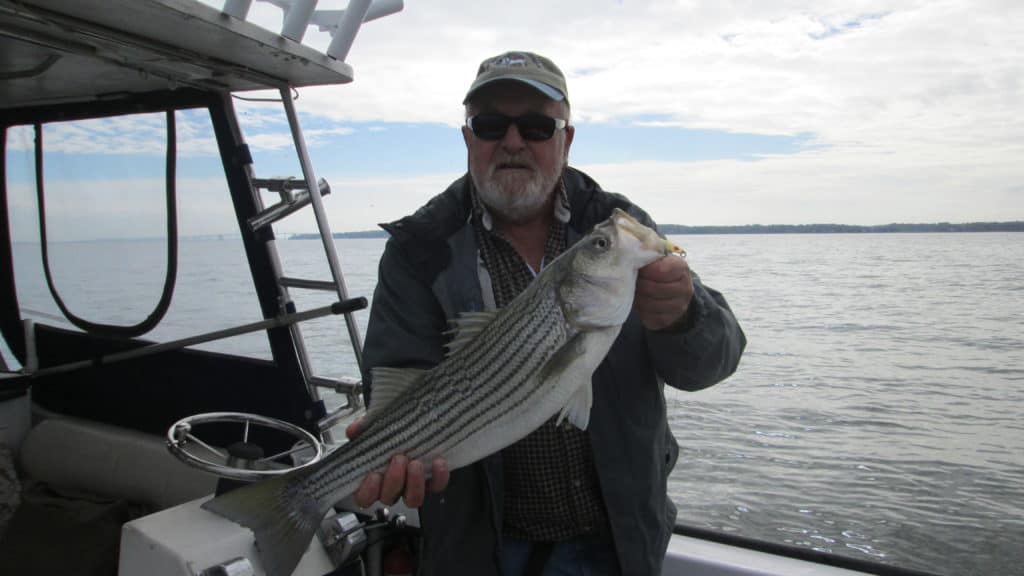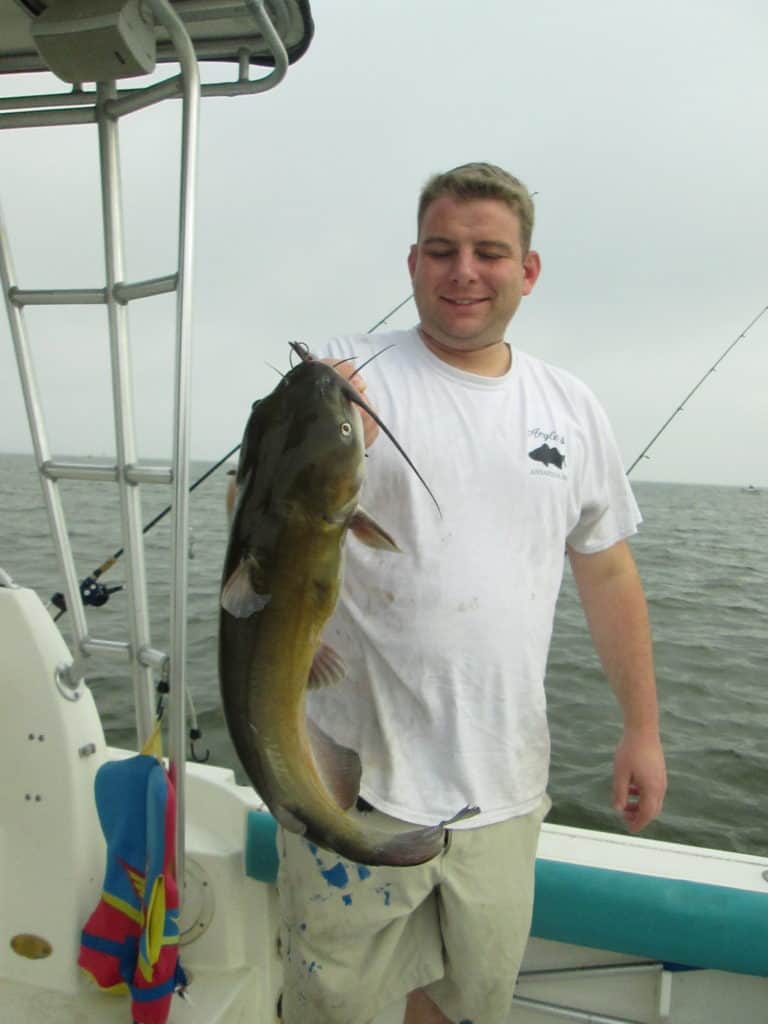Sporting Life

Dennis with another good autumn rockfish. 
Frank Tuma with a cold chunky weather rock. 
Mike from Anglers with tasty fall bycatch, a channel catfish.
Planning a Fall Fishing Day
By Dennis Doyle
If you’re going to carefully schedule a limited number of angling days this fall, picking the optimum day on the Chesapeake involves a number of variables, all of which should be weighed carefully. You must consider the weather, tide, wind and moon data for the date in mind. All of those categories substantially impact the rockfish bite on the Chesapeake this time of year.
Let’s assume you are intending to fish for stripers from a boat with the most efficient and simplistic method. That would be chumming with ground menhaden and fishing cut bait, either menhaden, alewife, bunker or pogy (all local aliases of menhaden). Let’s further confirm that you are using six to seven foot, medium to medium-heavy power spin or casting gear, spooled with 150 yards of 15- to 20-pound monofilament line, or gear close to that description.
We will also anticipate, for the best chances of success, that you are using circle hooks of 5/0 to 7/0 size on a 24-inch fluorocarbon, 20- to 30-pound test leader with a 2-ounce bank sinker attached to present the baits close to the bottom. And dead stick the rods—leave them in the holders until you’re sure the fish are hooked up well.
Providing you can arrange one day trip per week, the first decision is which day that should be. Checking the marine forecast and the tidal schedules will give you the first bits of important information. It will be prudent that winds for your day be forecast at about 10 knots or less for comfort. The winds should be in a direction that coincides with the tidal flow at the chosen area so your boat is trailing at anchor in a direction that allows your chum and your baits to trail aft from the stern. Locations involving 30-foot depths will generally be the better spots but, if there already are craft fishing in the location, anchor in their proximity. Aggregating chum is an effective strategy.
The next critical item is moon phase. Moonlight is not your friend; a bright, full moon will permit the rockfish lounging in your area to feed freely all night. They won’t be foraging energetically the following day. Pick the day of the week with the least portion of the moon visible after dark. An overcast sky may negate this rule to a certain extent.
When chumming during the fall at least some current is imperative. Both incoming and outgoing tides will fish well at some point but you want to avoid slack water. The tidal current commonly stalls an hour and a half after the peak high tide is scheduled for the area and will again stall an hour and a half after the low tide time.
As the tidal current completely changes direction the water flow becomes confused, your baits and boat trailing first one way then another, as well as your chum slick. That period lasts an hour or longer, during which the bite inevitably dies as well. If you cannot avoid those times, at least keep your expectations low. Monitor and modify your plans as the day nears to be sure these elements remain in effect.
Another challenge with a chumming setup, is that you are committed to place. If a large flock of seabirds start working over a feeding school of breaking fish a half mile away, a distinct possibility the time of year, you cannot take advantage without significantly disrupting and even terminating your chumming operation. Unless you are prepared.
Have a conspicuous, floating buoy with your DNR ID number inscribed readily available and have your chum bag rigged with a snap fastener. If you want to chase that tempting surface bite, you can then attach the chum bag and your anchor line to your buoy and immediately pursue the breaking fish.
Eventually when the fray subsides you can return and, if you failed to limit out on the breakers, resume your chumming operation with little or no opportunity lost. Being committed to a schedule and a tactic does not mean sacrificing flexibility.
Fishfinder:
The rockfish bite is improving, though the lackluster season in general has not established a very high standard to improve upon. Trolling seems to be the mode of angling most popular with small to medium sized bucktails trailing some type of paddle tail soft plastic. A spoon in the mix will help garner attention as will an umbrella rig. Reportedly, there is a hot bite going on in the Severn. The spot are still here for live lining but it’s a matter of days before they vamos back to the Atlantic. Perch are schooling up and moving toward winter grounds; you may find a fine bunch today but they won’t be there tomorrow. Lots of birds are working all about but they are over small to tiny rockfish. If you work a group of breaking fish throw small baits, letting them sink deep then cranking them back erratically. Crabbing continues to be excellent in most areas with six to seven feet currently being an optimum depth. There may be an influx of larger fish (stripers) as it gets colder (hey, it does happen). Hope springs eternal.
